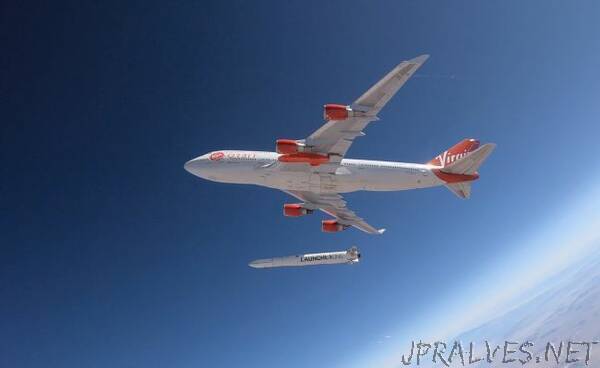
“The Virgin Galactic sister company performed its first-ever drop test today (July 10), releasing a LauncherOne rocket from its Boeing 747 carrier plane over California’s Mojave Desert.
“Now THAT’s what I call a drop test! Video from today’s very successful drop test of our #LauncherOne small satellite launch vehicle. More photos and videos coming soon,” Virgin Orbit representatives wrote on Twitter today.
Related: Gallery: Virgin Orbit’s LauncherOne Rocket for Satellite Missions
During operational flights, the 70-foot-long (21 meters) rocket will fire up after the drop and then carry its payload to orbit. But that didn’t happen today; the booster simply free-fell to the desert floor, where it presumably made a pretty big hole.
And that’s exactly how Virgin Orbit drew it up.
“We’ll be monitoring and rehearsing a million things, but this test is really all about those few seconds just after release, as we ensure the rocket and aircraft separate cleanly and observe how the rocket free-falls through the air,” company representatives wrote in a blog post yesterday (July 9).
Virgin Orbit, part of billionaire Richard Branson’s Virgin Group, has notched a number of milestones with LauncherOne and the carrier plane, known as Cosmic Girl, over the past year. The company first affixed the rocket to the plane last October, then flew the duo together for the first time a month later. A number of additional such “captive-carry” flights followed over the ensuing months, leading up to today’s drop test.
The first orbital flight of LauncherOne is the next big box to check. Virgin Orbit has not said when that will happen, but it will likely be relatively soon. The rocket that will fly that mission has already undergone extensive testing, company representatives said.
“Later this month, our integration team will wrap up that testing, mate the stages together and then hand the rocket off to our launch operations team,” Virgin Orbit wrote in yesterday’s blog post. “After that, our LaunchOps crew will run through the checks and rehearsals any serious rocket company does in the lead-up to a flight.”
LauncherOne is capable of toting satellites weighing up to 1,100 lbs. (500 kilograms) to a variety of destinations in low Earth orbit. Cosmic Girl will carry the rocket up to about 35,000 feet (10,700 m), at which point the booster will separate and make its own way to space. The plane, of course, will come back down to Earth for a runway landing.
Such air-launch systems are extremely flexible, making it possible to launch satellites to a variety of orbits with just 24 hours’ notice, Branson has said.
Virgin Galactic employs an air-launch strategy as well: A plane known as WhiteKnightTwo hauls the company’s six-passenger SpaceShipTwo aloft, and the space plane’s onboard rocket motor takes the craft up to suborbital space.
The newest SpaceShipTwo, known as VSS Unity, has already flown several test missions to suborbital space and should be ready to carry paying passengers soon, Virgin Galactic representatives have said.”
